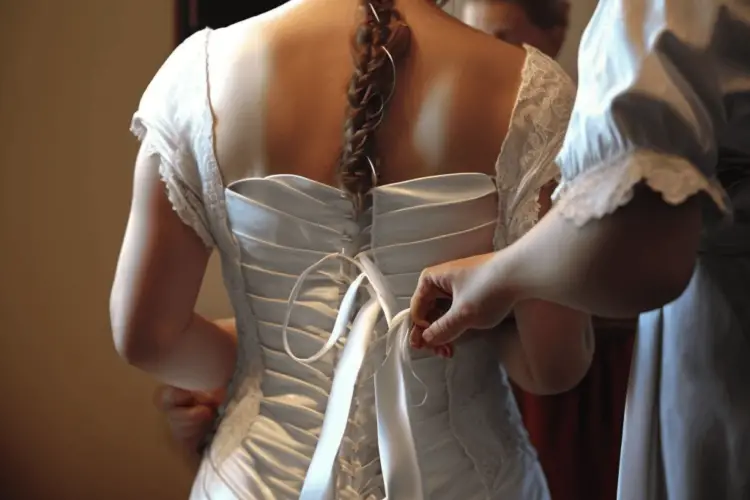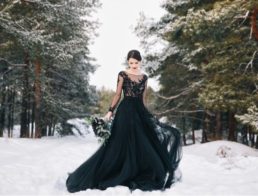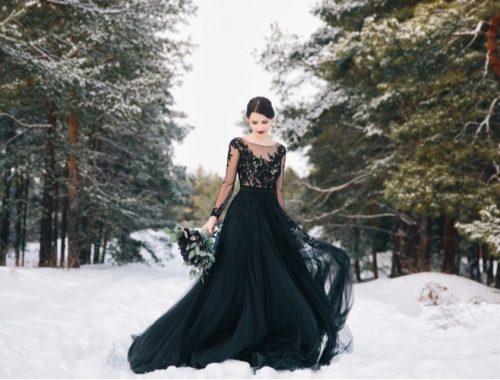Are you in the process of finding your dream wedding dress and have concerns about the sizing? You’re not alone, as many brides-to-be wonder: Do Wedding Dresses Run Small?
Take a look at our comprehensive guide on shopping for a wedding dress to help you navigate this important decision.
“The most important thing to remember is that every designer and label has their own unique sizing chart, so wedding dress sizes may not be what you’re used to,” says prominent bridal fashion expert, Linda Delaurentis.
68% of brides report needing alterations to their wedding dresses, which highlights the importance of getting accurate measurements.
We understand the stress of finding the perfect fit, and this article will address your concerns by explaining the reasons behind wedding dress sizing and providing tips on how to find the right size for you.
In This Article
Do Wedding Dresses Run Small?
Yes, many wedding dresses do run small. This sizing chart gives an indication of the typical conversion from standard dress sizing to most (though not all of course) wedding dresses:
| Typical Dress Size | Wedding Dress Size |
|---|---|
| 2 | 6-8 |
| 4 | 8-10 |
| 6 | 10-12 |
| 8 | 12-14 |
| 10 | 14-16 |
| 12 | 16-18 |
| 14 | 18-20 |
| 16 | 20-22 |
| 18 | 22-24 |
| 20 | 24-26 |
It’s important to keep in mind that wedding dress sizing can vary greatly between designers and even between different styles within the same designer’s collection. Don’t fixate on the actual size, but instead, focus on how your measurements compare to the particular line on the specific designer’s size chart. This will help you find the best fit for your body type.
Understanding Wedding Dress Sizes
How Wedding Dress Sizes Work
Wedding dress sizes are typically determined by measuring the bust, waist, and hips of the bride-to-be. These measurements are then compared to a standard size chart to determine the appropriate size for the bride’s body type. However, it’s important to note that wedding dress sizes can vary widely from designer to designer, and even from dress to dress within the same designer’s collection.
Many bridal shops carry sample dresses in sizes 8, 10, 12, 18, 20, or 22 for brides to try on. It’s important to keep in mind that these sample dresses may not be the exact size of the dress you end up purchasing. Alterations are often necessary to ensure a perfect fit.
Why Wedding Dresses Tend to Run Small
Many brides are surprised to find that wedding dresses tend to run small. This is because most bridal sizing is based on original European size charts from the 1940s, which were designed for a different body type than what is common today. In addition, bridal designers often use a “vanity sizing” system, which means that they label dresses with a smaller size than they actually are in order to make brides feel better about themselves.
It’s important to keep in mind that wedding dress sizing is not the same as street sizing. A bride who normally wears a size 10 in street clothes may need a size 14 or 16 in a wedding dress. This can be frustrating, but it’s important to remember that the number on the tag is just a number. What matters most is finding a dress that makes you feel beautiful and confident on your special day.
Tips for Finding the Right Size
Get Measured by a Professional
One of the most important things you can do when shopping for a wedding dress is to get measured by a professional. Don’t rely on your usual dress size, as wedding dresses tend to run small and vary by designer. A professional will be able to take accurate measurements of your bust, waist, and hips to help you find the right size.
Consider the Style of the Dress
When choosing a wedding dress, keep in mind that the style of the dress can affect the way it fits. For example, a fitted mermaid style dress may require a larger size than a flowy A-line dress. Be sure to try on different styles to see how they fit and feel before making a final decision.
Leave Room for Alterations
Even if you find a wedding dress that fits perfectly, it’s always a good idea to leave room for alterations. This will ensure that your dress can be tailored to fit your body perfectly, and that you’ll feel comfortable and confident on your wedding day. Be sure to budget for alterations when planning your wedding dress budget.
By following these tips, you can find the perfect wedding dress size that will make you look and feel your best on your special day.
Brands that Run Big & Small (With Chart)
When it comes to wedding dresses, finding the perfect fit can be a challenge. Different brands have different sizing charts, and some may run big or small compared to others. Here are some brands that are known to run big or small, along with a helpful chart to guide your dress shopping:
Brands that Run Big
If you’re looking for a wedding dress that runs on the larger side, you may want to consider these brands:
- David’s Bridal
- Maggie Sottero
- Watters
These brands are known for their generous sizing, so you may want to consider sizing down when ordering your dress.
Brands that Run Small
If you’re looking for a wedding dress that runs on the smaller side, you may want to consider these brands:
- Pronovias
- Enzoani
- Justin Alexander
These brands are known for their more narrow sizing, so you may want to consider sizing up when ordering your dress.
Wedding Dress Sizing By Brand
Here is a helpful chart to guide you in finding the right size for your wedding dress:
Remember, every brand is different, and it’s always a good idea to try on dresses in person to get a better idea of the sizing. Don’t be afraid to ask for help from a sales associate, and always keep in mind that alterations can be made to ensure the perfect fit for your big day.
| Brand | Size Range | Typical Sizing |
|---|---|---|
| David’s Bridal | 0-30 | Runs big |
| Maggie Sottero | 0-28 | Runs big |
| Watters | 00-24 | Runs big |
| Pronovias | 0-28 | Runs small |
| Enzoani | 0-20 | Runs small |
| Justin Alexander | 0-32 | Runs small |
Frequently Asked Questions
Do wedding dresses run small?
It depends on the brand and style of the dress. Some wedding dress designers may use different sizing standards, and some dresses may be cut smaller or larger than others. It’s always a good idea to consult the size chart provided by the designer or retailer, such as in our guide to wedding dress sizing, and to try on dresses in person if possible.
How should I choose the right size for my wedding dress?
The best way to choose the right size for your wedding dress is to consult the size chart provided by the designer or retailer, and to take your measurements accurately. Our article on how to measure for a wedding dress offers helpful tips. Keep in mind that it’s usually easier to take a dress in than to let it out, so if you’re between sizes, it’s often better to choose the larger size.
What if my wedding dress doesn’t fit perfectly?
Most wedding dresses will require some alterations to achieve the perfect fit, even if you’ve chosen the correct size. A professional seamstress can make adjustments to the dress to ensure that it fits you comfortably and flatters your body shape. Learn more about how many sizes a wedding dress can be taken in.
Should I order a wedding dress that’s a size smaller to encourage weight loss?
It’s not recommended to order a wedding dress that’s a size smaller with the intention of losing weight before the wedding day. Losing weight is not a guaranteed outcome, and it’s much easier to take a dress in than to let it out. Instead, consider choosing wedding dresses that make you look slimmer. It’s usually better to order the size that fits you best at the time of purchase and make adjustments if necessary closer to the wedding day.
How far in advance should I order my wedding dress?
It’s recommended to order your wedding dress at least six to nine months in advance of your wedding day. This allows enough time for the dress to be made, shipped, and for any alterations to be completed. If you’re ordering a custom dress or a dress that requires more extensive alterations, you may want to allow even more time. For specific designers, like Stella York wedding dresses, check their guidelines on when to order and how their sizing works. Additionally, find out what height wedding dresses are made for and explore plus-size wedding dress options if needed. Some brides may also wonder if wedding dresses come with built-in bras, which is another consideration to make when choosing the right dress.










